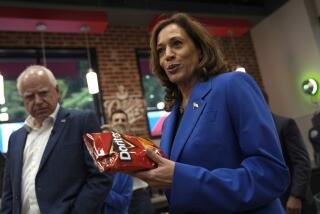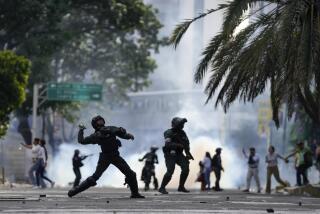Latin Countries Rediscover Joys of Capitalism
BUENOS AIRES — Across Latin America, governments are throwing out their welfare-state economic recipes and reaching for free-market textbooks to escape the devastation of the region’s “Lost Decade.”
As the 1990s approach, the trend from Mexico to Argentina is toward cutting deficits and opening up stilted economies. There are only a few holdouts, such as Peru and Brazil, but coming presidential elections appear likely to bring those countries aboard as well.
In effect, the new realism acknowledges that protectionist policies and state domination of the economy, the norm since World War II, have uniformly brought disaster. Campaigns are in progress to privatize government companies, slash subsidies, collect taxes and join the world marketplace.
In a region where elected governments have steadily replaced dictatorships, leaders are struggling to show their compatriots that democracy need not mean instability, inefficiency and hunger.
Most economists and political analysts agree that the trend has less to do with a swing from left to right than with the recognition that bad management and closed doors merely bring brutal inflation, which ultimately ravages the poor most of all. Once the fiscal house is in order, governments will be able to devise liberal or conservative policies, as they choose.
“It has become obvious that when a government loses control over its own finances, it cannot begin to control the rest of the economy. One cannot have any economic policy without fiscal order,” Argentine economist Daniel Heymann said. “This is almost a question of survival. To stabilize the economy is indispensable, whatever the ideology.”
Changes in Nicaragua
Even Nicaragua, a proving ground for Marxist revolution for the last decade, has thrown out its old models, hacking away at government deficits and slashing inflation in the process. Recently elected populist presidents in Argentina and Venezuela also surprised their critics by embracing sweeping economic reforms that could well have been drafted by the International Monetary Fund, long a bogyman for some Latin governments.
Nowhere have these adjustments come without a price; more than 200 died in bloody rioting in Caracas after Venezuelan President Carlos Andres Perez, a free-spending populist during his previous term, adopted a severe austerity plan after his inauguration.
The restructuring programs have often meant trading high inflation for severe recession as the cutbacks bite. But the consensus is growing that there is no alternative to escape from cycles of more inflation, more violence and a further decline in competitiveness with the rest of the world.
The U.N. Economic Commission for Latin America and the Caribbean (CEPAL) reported in September that by year’s end, the per capita gross domestic product for the region will be 10% below that of 1980. The majority of countries “find themselves debating whether to choose stagnation or inflation.”
Yet those countries that took the lead in opening their economies through often wrenching structural changes--principally Chile, Bolivia and Mexico--have begun to collect dividends.
Chile is in its sixth straight year of growth, likely to exceed 6% for 1989; unemployment has fallen to 6.6%, and real salaries have risen. Although inflation rose to 18% annually in August from 11% the previous year, it remains a pittance compared to rates elsewhere of 25% and more per month. While other countries’ foreign debt has soared, Chile has cut its commercial bank debt by $7.5 billion since 1985, mainly through debt conversion programs. Exports rose 17% in the first six months of the year.
Backed by Opposition
Chile’s liberal-left opposition coalition, expecting to triumph in December elections, has pledged not to stray from the free-market principles of Gen. Augusto Pinochet that created this rare example of growth.
Referring to hyper-inflation and economic disintegration in neighboring countries, Chilean opposition economist Sergio Bitar said: “The Argentine and Peruvian experiences have been very important for the opposition here.
“In Chile, we all realize that we begin the ‘90s with a great opportunity, and we cannot spoil it. If we succeed, we will show that there is a chance to combine democracy and economic efficiency. In recent years, these have seemed mutually exclusive.”
Bitar described what he called a two-pronged trend in Latin America: “First, there has been an opening of economic policy, which means new tariff structures and exchange rate policies. Second, policies have been oriented toward macro-economic equilibrium, through fiscal and monetary policies, with far less administrative regulation and the privatization of numerous state-owned enterprises.
“It is an important tendency, and it is a pragmatic change, not ideological,” he said. “But we must still see whether this type of change is viable, what impact it will have on democracy. In both Venezuela and Argentina, the impact has been very intense. . . . Nevertheless, so far the reaction by politicians and unions has been less paralyzing than expected. This is probably due to the awareness that there is no alternative.”
A Latin American economist in Washington for a multilateral organization said that in regional meetings this month, “the old approach of blaming the region’s woes on the international debt crisis was no longer there. Instead people looked at individual countries--Chile, Mexico, Uruguay and the way Argentina is evolving--and it was clear that fewer and fewer countries are not going in that direction.
“Countries like Argentina look in the mirror of Chile,” the economist said. “Clearly, that is having a snowball effect. There is a recognition that you cannot survive with a populist solution because there is no wealth to redistribute. It is a matter of cleaning house.”
Shake-Up in Bolivia
Another model is Bolivia, where former President Victor Paz Estenssoro used government austerity and free-market policies to cut inflation from more than 20,000% a year in 1985 to 10%. His successor, President Jaime Paz Zamora, is a democratic socialist and former Marxist, but he has said the first challenge will be to maintain stability while promoting growth.
“To meet this challenge requires a strict respect for the economic principals of fiscal discipline (and) the free play of supply and demand,” Paz Zamora said in his inaugural address in August.
Neighboring Paraguay, historically an isolated island of old-boy networks and corruption, also appears headed for the world marketplace. After deposing dictator Alfredo Stroessner in a coup in February, Gen. Andres Rodriguez won a relatively free and fair election and immediately imposed measures to free up and modernize the economy.
Perhaps the most dramatic example is Nicaragua, which fully embraced economic orthodoxy at the end of last January. It has since laid off 16,000 workers, reduced the army by 10,000, cut spending in half and shrunk the budget deficit from 44% last year to 7% in the first half of 1989.
Gasoline rationing, in effect since 1981, ended last month as price subsidies were removed and market forces took over. Inflation, 36,000% last year, fell to 5.2% in the month of August.
“These are the most spectacular results achieved in Latin America in the last 20 years, except for the case of Bolivia,” Planning Minister Alejandro Martinez Cuenca said.
Economy Minister Luis Carrion Cruz, one of nine comandantes in the Sandinista leadership, said that the demise of the U.S. Contra policy played a major role in the new program, designed by Western economists with Swedish funding.
“We couldn’t have done that in 1984 or 1986. The previous economic policy was determined fundamentally by the need to defend the revolution,” Carrion said.
The election of right-wing President Alfredo Cristiani in El Salvador this year brought market-opening measures and reduced subsidies for domestic producers, although doubts persist that the changes will be dramatic.
Argentina Takes the Plunge
Argentina is the most recent case of a headlong plunge into orthodoxy. Carlos Saul Menem, the Peronist party president who took office in July amid the nation’s worst inflation ever, stunned the country with the severity and depth of his reforms. Emergency economic laws slashed subsidies and other privileges that long underpinned the economy, and Menem raised public service prices by up to 600% to balance the budget.
He also launched a program to privatize state-owned businesses such as the phone and oil companies, and he cut inflation from 196% in July to an estimated 5% this month.
Argentina has operated literally without an approved annual budget since the return of democracy in 1983, thus removing Congress’ power to control spending and giving far greater power to special-interest pressures.
“We still have to learn to make this system work within the context of democracy,” economist Heymann said. “But I would like to think that we are undergoing a bath of realism. And I hope that one day our countries will be boringly stable.”
Both Peru and Brazil appear to be in the phase Argentina endured in the first half of the year, when an outgoing government with little credibility saw itself smothered by hyper-inflation. Some economists suggest that such a crisis is necessary to induce the will to make hard choices.
Fernando Collor de Melo, the front-runner in Brazil’s November election, has promised a pro-capitalist policy that would reduce the role of government and encourage free-market forces. While insisting that the state has a responsibility to narrow inequalities, Collor said, “Capitalism does not coexist with a gigantic, irrational, corrupt state, nor does it survive without competition, with subsidies and favors.”
In Peru, novelist Mario Vargas Llosa commands the lead in the campaign for the presidential election next April on an even more severe free-market platform. President Alan Garcia has watched his heterodox program of spurring consumption through subsidies collapse into devastating inflation of 5,700% annually, with a 50% fall in real incomes. The gross domestic product slid 20% in the first half of this year as Garcia’s gradualist reform measures stayed a step behind the accelerating inflation.
Peruvian economist Guido Pennano said that “the case of Peru is important, in the sense of how not to do it.”
He argued that even if leftist candidate Alfonso Barrantes wins the election, drastic reforms will be enacted. “Since the debt crisis, the deterioration of these states means there is little room to go left or right, there are few options.
“This is a product of . . . the failure of the protectionist policies, of the welfare state,” Pennano said. “We never created the welfare, only the state. We gave welfare to nobody.”
Times staff writers William R. Long, in Brazil, and Richard Boudreaux, in Nicaragua, contributed to this story.
More to Read
Sign up for Essential California
The most important California stories and recommendations in your inbox every morning.
You may occasionally receive promotional content from the Los Angeles Times.










